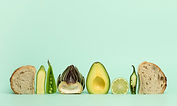
Understanding Food Labels
Whether you see them on a package of eggs at the grocery store, on labels on fish, chicken, and beef, and on menus at restaurants, we hear the terms like "organic," "cage-free," "farm-raised," "free-range," "grass-fed," "natural," and many others everywhere these days, but which one is better?
#1- Eggs:
Pasture-raised when possible
A pasture-raised egg has more vitamins A, E, and omega-3 fatty acids and less cholesterol and saturated fat than a conventional egg.
To qualify as "pasture-raised," The Humane Society of the United States describes that birds must be placed on a pasture for at least six hours each day, each hen must have at least 108 square feet (15,552 square inches) of pasture, and the pasture must be covered mainly with living vegetation.
#2 - Poultry:
Free-range, organic when possible.
According to the USDA, The term "free-range" certifies that birds must have access to the outdoors. However, there's no requirement about how large the outdoor area needs to be.
A study found that protein, total collagen, zinc, and iron in thigh meat and total collagen content in breast meat of the free-range hens were higher than in conventional hens.
All organic agricultural farms and organic products must meet guidelines, including refraining from using synthetic fertilizers and pesticides for three years before certification and continuing to do so for the term of the organic license, no GMOs, avoiding antibiotics and hormones, and keeping the animals fed with 100% organic products.
#3 - Beef and pork:
Pastured or grass-fed when possible.
Meat from grass-fed cattle and pigs has higher protein, omega 3, and vitamin E levels and less saturated fat than conventional meats.
"Pasture-raised" indicates that the animal was raised on open ground and ate grass and feed found in a pasture rather than being fattened on grain in a pen or barn. Grazing cattle and pigs is a traditional farming technique that allows animals to be raised humanely, where animals can move freely, carrying out their natural behaviors. "Pasture-raised" indicates more that the animal was raised outdoors.
Grass-fed tag. This tag means the animal is fed grass, its natural diet, instead of grains. In addition to being a more humane option, meat from grass-fed animals is leaner and lower in fat and calories than meat from grain-fed animals.
Grass-fed animals are not supplemented with animal by-products, synthetic hormones, or antibiotics given to promote the animal's growth and prevent disease – despite antibiotics might being given at some point to treat disease.
The "grass-fed" label does not necessarily mean that the animal ate grass for its entire life. Some grass-fed cows are "grain-finished," meaning that these animals ate grain from a feedlot before being slaughtered.
#4 - Seafood:
Wild-caught from sustainable fisheries when possible.
Wild fish offers a more balanced ratio between omega-3 and 6 fatty acids than farm-raised fish.
Due to the varied diet that wild fish eat offers us a greater variety of nutrients when we eat them. Farm-raised fish, on the other hand, eat a controlled diet.
Wild fish move more and have more muscle (protein) and less fat. It feeds on what it finds in the water (good and bad), and its meat has a more pleasant texture and better flavor. But it's getting harder and harder to catch.
Notes on mercury and neurotoxins
Larger fish, such as swordfish, for example, can have a lot of mercury in their blood, and farmed fish can have lower levels of mercury than wild-caught fish.
In addition, greater control of the water from the fish farm prevents the presence of neurotoxins from algae, protozoa, and bacteria, as well as various parasites, in addition to the anisakis.
#5 - Dairy:
Organic dairy products from grass-fed animals when possible.
Grass-fed dairy products have more omega-3.
When cattle eat grass, they obtain higher amounts of phytonutrients and antioxidants through the food they eat.
Grass-fed dairy comes from the meat of animals raised in pastures and not fed with grains.
Conjugated linoleic acid, or CLA, is a fatty acid with multiple benefits, such as reducing cholesterol and fat levels. This substance is higher in grass-fed cows than in conventional milk.
Grass-fed dairy products have several animal welfare benefits. However, it only sometimes meets environmental sustainability efforts.
When selecting what foods to consume, we shall seek producers that behave ethically by employing core values encompassing good animal welfare, environmental protection, and applicable safety practices to grow food.





Σχόλια